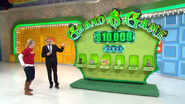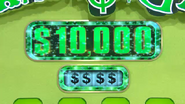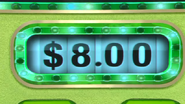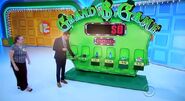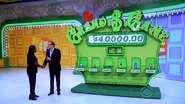Grand Game is where the contestant picks products under a target price to win up to $10,000 in cash.
Gameplay
The contestant begins with $1 displayed on a game board and a "target price." The contestant is then shown six grocery items, four of which are priced below the target price and two of which are priced above.
The contestant selects an item they believe is less than the target price. If they are correct, their winnings are multiplied by ten to $10. This is repeated for two more items, multiplying to $100 and then $1,000. To this point, if a contestant selects an item priced above the target price, they leave with the amount shown on the board, including $1 for choosing incorrectly on the first pick.
After winning $1,000, the contestant may quit the game and keep the $1,000 or risk it to choose the one remaining product that is less than the target price. if the contestant succeeds by picking the last item that is below the target price, they win the top prize of $10,000. If it is not, the contestant Wins nothing.
History
The game premiered on May 16, 1980. The first win in Grand Game was on November 10, 1980, the eighth playing. The winner, a Samoan named Pauline Anderson, proceeded to chase Bob Barker around the stage resulting in a classic moment seen in many clip specials. The music sting used to introduce the game is the last few seconds of the theme to Family Feud. From 1992-1994 the game used the updated Family Feud theme heard on that show during 1988. Before and since, the original Family Feud theme used in 1976 is heard. On 1994's syndicated The New Price is Right, small prizes replaced grocery items and target prices ranged from $50 to over $100, and was accompanied by the Fortune Hunter Intro Cue.
Originally, the Giant Price Tag was placed all the way down, meaning the top of the Grand Game sign would be seen, thus ruining the mystery of what game would be played next. Later on, the Giant Price Tag was raised up, and a different opening shot was used.
On March 6, 2000, a new font was introduced for the "$10,000" portion of the game. However, the ".00" retains the original font style until it got replaced on April 4, 2000.
Starting in 2002, Grand Game's top prize for prime time specials is $20,000, with the rest of the prize ladder being $2, $20, $200, and $2,000.
On September 4, 2012, Grand Game was played for $40,000 to celebrate 40 years of Price is Right, The contestant lost the game on the last pick. The rest of the prize ladder was $4, $40, $400 and $4,000.
On April 23, 2013, for Price's "Big Money Week", the Grand Game was played for $100,000, starting out at $10, with the rest of the ladder being $100, $1,000 and $10,000. The contestant won only $1,000.
The appearance of Grand Game was updated on April 2, 2013, to include an updated Grand Game sign and new electronic displays for the money ladder and target price. If the contestant loses, the flashing lights on the two displays stop flashing and "freeze". If the contestant loses everything on the fourth shot, both electronic displays turn red and the money ladder goes down to $0.
Foreign versions of Grand Game
While Grand Game's rules in other countries tend to be the same as the US, they may have different cash prizes, such as $2,000 on Canada's Misez Juste or 10,000₣ on France's Le Juste Prix (equalling about US$2,000 after conversion to the euro).
Germany's Der Preis ist heiß was overhauled for their version, called Vier mal die Nul (Four times the Zero). To win the DM10,000 grand prize, a contestant had to pick which was the correct product to a given question (i.e., which costs more?). Like the US, they started at DM1, and they used grocery products.
Pictures
1st Look
2nd Look
Alternate Setups
YouTube Links
First $10,000 win with an out-of-control contestant
Another $10,000 Win!
$1,000 Bailout
Another $1,000 Bailout
Grand Game for $40,000


